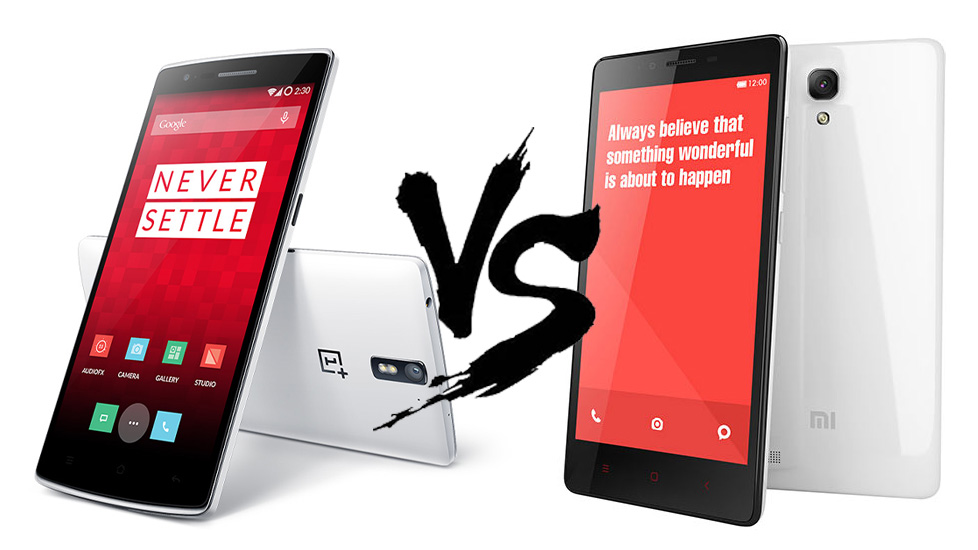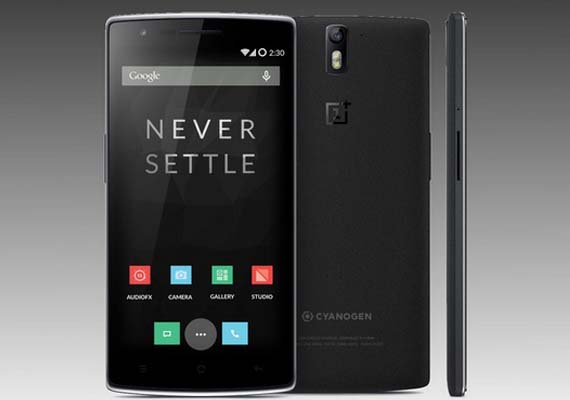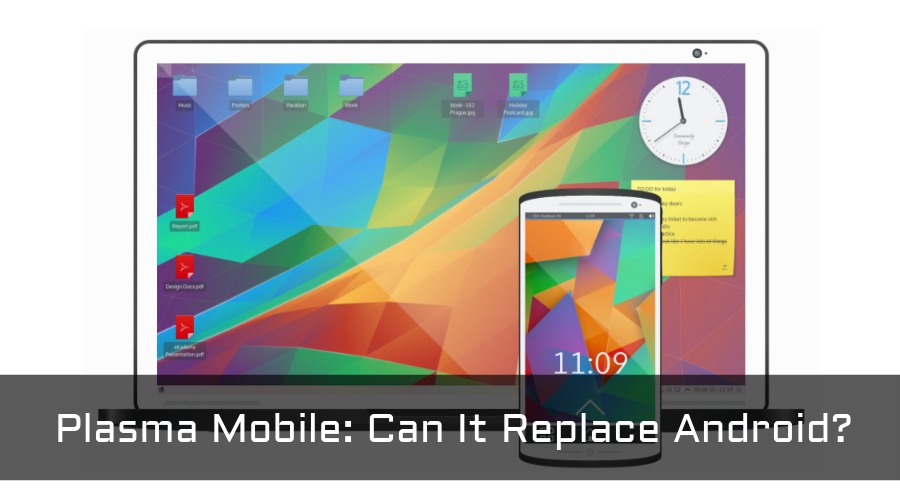2nd December is an important day for the Indian budget smartphone market. It marks the induction of two smartphones into the market, made by two Chinese manufacturers having a similar ideology – To offer the buyer a phone having good hardware at the lowest price possible. To achieve this both the companies cut corners, albeit sensible ones. For example, you will be hard pressed finding any advertisement for the two phones I am about to compare.

On the left is the One from OnePlus. This one (pun intended) is a monster, powered by a Qualcomm Snapdragon 801 processor, Adreno 330 GPU and 3 gigs of ram. It can blaze through any apps/games with ease which look fantastic on the 5.5″ 1080p display. A 13 megapixels camera adorns its back which has a Sony Exmor sensor and an f/2.0 aperture. Low light doesn’t scare it at all.
On the right we have the Xiaomi Redmi Note. Don’t get fooled by it’s simple design, it packs quite a punch. An Octa-core MediaTek soc with 2 gigs of ram, throw anything at it and it will come on top. The 720p display has great viewing angles and a not too shabby pixel density of 267 ppi. The main shooter is a 13 MP camera which comes with an f/2.2 aperture.
Now that we are done with the intros lets get on with the actual comparison of the two i.e. OnePlus One vs Xiaomi Redmi Note
Price:
The OnePlus One’s price has not yet been announced, but it is expected to be below Rs. 25k for the 64 GB variant and below Rs. 20k for the 16 GB variant. Such specifications at this price point are unheard of. However, the phone is an Amazon exclusive and is available only through an invite system.
How to get an invite : 5 Ways to Get OnePlus One Invites in India
The Xiaomi Redmi Note is also available in two variants- Redmi Note and Redmi Note 4G. The Note 4G supports LTE bands and the company claims that they have integrated this support keeping the Indian scenario in mind. The Note is available for Rs.8999 and the Note 4G is available for Rs.9999. This comparison talks about the Redmi Note and not the 4G variant because its date to go on sale has not yet been revealed and is expected to be in mid-december. The phone is only available through flash sales that periodically occur on the Flipkart site for which you have to register beforehand.
Okay, so now that we have the prices out of the way lets talk about what that money buys us in some detail.
Design:

OnePlus clearly takes the designing of a phone seriously. The looks of the phone are gorgeous. The back panel is available in two variants- Silk white and Sandstone black. The sandstone black variant actually has a sandstone like finish. It is nothing like ever seen before. You would not want to put a case on the body after touching it. There is no slipperiness and the gentle curve of the back makes it easy to hold. At 162gm the device feels light yet solidly built. The silk white variant is smooth and nice to the touch but the black wins this one.

Xiaomi Redmi Note continues with the bland design of the previous Redmi. This time they have done away with the dark panel of the 1S and traded it for a white slippery cheap looking plastic which is also a finger print magnet. There is also a tiny little bump of the camera sensor on the back so it would be better if you buy a case so that the camera window is not scratched. It tips the scale at 199g. The red accent on the three capacitive buttons below the screen looks good though.
Display:
Staying true to the phablet name, both the phones have huge 5.5 inches of display real estate though they differ in their quality.
The 1080p screen on the One gives a whopping 401 ppi. Images, text and everything in general is super crisp and sharp. The IPS display has great viewing angles and Corning Gorilla Glass 3 provides protection from scratches to it. The outdoor visibility of the screen is good so is the color reproduction. This panel is almost as good as the one on the iPhone 6 Plus. Yes! it’s that good.
Xiaomi has outfitted the Note with an IPS 720p display that gives an approximate pixel density of 267 ppi. A 720p display is expected at this price range and the Note delivers, but if being able to make out pixels on the screen makes you sick to the stomach, the OnePlus One is a better choice. There is no gorilla proofing either so better get a scratch guard for it.
Processing Power:
Quad-core Qualcomm Snapdragon 801 processor clocked at 2.5 GHz along with an Adreno 330 GPU is the combination that powers smartphones of the likes of Samsung Galaxy S5 and the Sony Xperia Z2. So you can safely bet that the OnePlus One stands shoulder to shoulder with the greatest and fastest of the flagships of recent times. 3 GB of RAM is ample for any amount of multi-tasking you might desire.
‘True’ Octa-core MediaTek MT6592 clocked at 1.7 GHz along with a Mali-450 GPU is the fastest SOC offered by MediaTek. Its multi-core performance is top-notch and is consistently comparable to the Snapdragon 800. But the Mali-450 is only slightly better than the Adreno 305 which is an average performing GPU. So the overall performance should be smooth and snappy but you will not be able to enjoy the most graphics intensive applications in all their glory. 2 GB of RAM is more than sufficient for general day to day usage, so you don’t need to worry about less RAM.
Camera:

The 13 MP sensor on the One is a Second generation Sony Exmor sensor that gives stellar results. It has 6 lenses to avoid distortions and aberrations in the resulting photos and a dual-led flash to light up the scene when needed. The large aperture size of f/2.0 should give less noise in low-light conditions. It will let you shoot upto 4K videos and for those who like slo-mo videos, 720p film at 120 fps. The only thing lacking on this camera is an Optical Image Stabilisation feature that current flagships have. To make up for that OnePlus claims to have put 120 algorithms to work in their IS+ feature to help you shoot sharp and stable photos and videos.
Also Read : World’s Largest Selfie Captured by Lumia 730 in Bangladesh
The primary shooter on the Redmi Note is also a 13 MP camera but with a f/2.2 aperture. The lens is a 28 mm wide angle lens that should give you enough room to take a beautiful landscape or to fit everyone sitting in a party hall. On the video front, the camera shoots up to 1080p video. But there’s no high fps mode on this one. Xiaomi has not revealed the manufacturer of the sensor so we don’t have anything to infer the image quality from, but the quality should be comparable to what is generally seen in this price bracket ie. average. That means it will keep you happy as long as you don’t expect dazzling results from it.
Both have 5 MP front-facing cameras that should be decent enough to handle your selfie sessions.
Battery:
With such hardware the phones need some serious juice to get through the day. To handle that,both companies have embedded a 3100 mAh battery into the phones. The batteries are non-removable in both the devices. The overall battery life of the Redmi Note should be better as the screen would use lesser energy as it has lesser pixels but there is not much that separates these two in this department.
Storage:
The OnePlus One offers a fixed amount of emmc storage with no option to expand it as there is no micro-sd slot in the phone. For the inbuilt storage, you get to choose between 16 GB or 64GB. Obviously, you pay more for the larger memory one. You will have to decide that spending 5k for more memory is worth for your usage style or not.
Redmi Note comes with 8 GB of ROM of which approximately 5.5 GB would be user accessible. But memory cards of upto 32 GB capacity are supported. Rejoice!
Connectivity options
The One is a single SIM 4G capable smartphone. In addition to the standard connectivity features of Wi-Fi and Bluetooth, the One also offers NFC. Though the uses of NFC are limited as of now, it is good to have it for future proofing.
The Note, on the other hand is a dual-sim capable phone but lacks NFC.
Again your usage will be the deciding factor.
Also Read: Next-Gen Superfast WiFi Technology from Samsung
UI:
Both the devices run Android but unlike most manufacturers their offerings differ substantially.

OnePlus One is originally a CyanogenMod based phone which is basically stock android with a few tweaks and infinite options of customizability. According to the latest news, Cyanogen has partnered with Micromax in India which denies CM to support any other manufacturers in India. This means your One will not come with CM installed as only Micromax has rights to use CM in India. In response to this OnePlus has announced that they have started work on an Android Lollipop based system that they will release in beta in December. This system is what you’ll get when your device is shipped to you. They expect it to complete by February next year and use it on any other phones they decide to make.
Redmi Note, on the other hand, uses the MIUI interface by Xiaomi which is an amalgamation of the look of iOS and Android. MIUI is smooth, but the Android version it’s based on is 4.2 Jellybean which is now two versions old. A lot has changed in Android since the Jellybean days, but it’s all missing from this phone. Xiaomi has announced Lollipop update for the Mi3 and that they will then move on to the Redmi devices. It is expected that after the rollout for Redmi 1S is over the Redmi Note and Note 4G will get the update, which might take some time.
So, on the OS front both have their own problems and only time will sort out these issues. At the moment you are actually going a little wrong with either of them but nothing major to rule these phones out completely.
Summary:
At almost half the price of the OnePlus One, the Redmi Note offers very capable hardware but severely lacks in the design department. Though it is not an ugly phone it is not particularly eye catchy either. It is a decent phablet and very aggressively priced. It is easily the best phablet below 13k.
If you have an extra 10k lying somewhere, then the One by OnePlus is a compelling proposition. The hardware on offer here is what used to be the fastest SOC a month back. The camera is marvellous and the screen is lovely. For under 25k you get a phone which could easily be priced near the 40k mark.
Now, if we look at sheer bang for the buck, both have much of an equal footing, as the kind of specifications on offer here are unheard of at the respective price points. But prying deeper into the competition you can see that the Xiaomi Mi3 had much better hardware and design than the Note for just 5k more. Though its not fair to compare the Note to it’s own bigger brother (which is not even on sale anymore) but it is an achievement for Xiaomi that they could build such a phone and sell it for the price they did. The Micromax Canvas Knight whichcanbe had for around 15k beats the Note fair and square. The same drill for the One reveals that only the current crop of flagships like Nexus 6 or LG G3 have better specs. This means that if you want to buy a phone better than the One you have to go above the 40k mark which is 15k more than its price. Comparing directly to theRedmi Note the extra 10k buy you a better processor, more RAM, far better camera and vastly better design and build quality. So according to me the most value for moneyphablet out of the two is the OnePlus One. Peace!
Share the “OnePlus One vs Xiaomi Redmi Note” comparison if you found it helpful!










